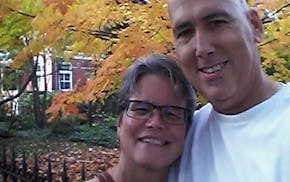They call it "Suicide Hill" because the homeless and addicted people who gather there sometimes pass out and roll down the embankment into traffic.
The area, near where Lyndale and Hennepin intersect in a crisscross of bridges, underpasses and grassy meridians, has been the site of assaults, fights and accidents. Inebriated members of an extended "family" of homeless people often stumble into heavy traffic. A few weeks ago, I nearly hit a man who zigzagged unsteadily through several lanes of whizzing cars and trucks, barely making it to the other side. Others have not been so lucky.
Some of the panhandlers have been known to get aggressive and knock on the windows of stopped cars or even sit on their hoods.
Well-meaning drivers and self-styled activists have fueled the behavior by dropping off couches, chairs and BBQ grills. The homeless squatters have told outreach workers that this generosity showed them that their encampment was wanted here.
Over the July 4th weekend, however, one inebriated young woman was badly assaulted. After she passed out, the assailants painted obscene images on her body with markers, then photographed it and put it on social media.
That's when Jana Metge got busy.
Metge, executive coordinator for Citizens for a Loring Park Community, started calling community leaders, and the neighborhood began a series of meetings over the summer that grew to include elected officials and nonprofits.
"It's the widest group of people ever assembled to work on homeless issues," said Michael Goze, CEO of the American Indian Community Development Corp. "It was the neighborhood, state, county, transit, police, courts. St. Stephen's [Human Services] was instrumental."
At the first neighborhood meeting, Goze said people seemed mostly focused on removing the problem. "By the second meeting, they got it," he said. "The light bulb went on. These people are not going away. Police can't do it alone. Courts can't do it alone. There needs to be a longer vision. I think it's really important that it's come to this."
Metge said the Suicide Hill group has been around, and growing, for several years. It's also one of dozens of encampments around the Twin Cities in areas just out of sight of very public locations.
"If you talk to them, they say people can tailgate and drink wine outside of the Walker, but we're poor," Metge said. "Folks just want a place to hang."
This summer, it got exponentially worse. People who were not homeless began to join the parties, sometimes just to socialize with people they had met on the street. "It was not a healthy or safe place for anyone," Metge said.
Minneapolis police assigned beat officers to the area, and they began to talk to the participants about safety issues and alternatives. St. Stephen's sent workers to assess needs of the homeless, and in some cases find housing or get them into treatment.
The state transportation department began weekly cleanup of the site with a hazmat team, and City Council member Lisa Goodman, who represents the area, found money to hire American Indian outreach workers. Prosecutors identified the most problematic of the group and are working with Minneapolis police to find the best solution for each.
Metge, who lives in Phillips and knows some of the families of the people involved in the Lyndale problem, said the neighborhood knew it "was not good enough to just move people to another neighborhood. Everybody wants to figure this out."
Even though the problem crowd has thinned substantially, more than 50 volunteers gathered last week to continue to work on the issue and track where the homeless went. "It nearly brought tears to my eyes," said Metge. "We're not going away. Wherever they go, we will be there."
The challenge, said Gail Dorfman, executive director of St. Stephen's, is a lack of affordable housing, plus the poor criminal or housing records of the individuals. "They are a tough group to house," she said. "They sense that the encampments, while not perfect, meet their needs."
That's partly because generous people continue to help them, Goze believes.
"People don't understand that if you give them $5, it's costing us $500 to address the result of their behaviors," he said. "The bottom line is they create a mess wherever they go."
Goze said we're lucky that we live in a giving city, but when people help panhandlers, "It's not helping."
He and others recommend donating to organizations that are looking for solutions. Yes, they know it looks self-serving, but simply handing out money or bringing a meal has not worked.
"People are giving their hearts," Goze said. "I'd ask them to use their heads."
jtevlin@startribune.com • 612-673-1702
Follow Jon on Twitter: @jontevlin

Tevlin: 'Against all odds, I survived a career in journalism'

Tevlin: Grateful Frogtown couple fight their way back from fire and illness



